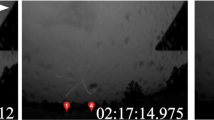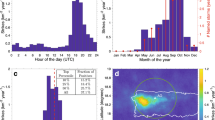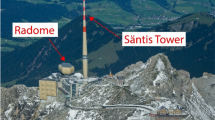Abstract
IT is now generally accepted that the source of atmospheric radio noise is the natural lightning discharge associated with thunderstorms, the discharges possessing energy components throughout the radio-frequency spectrum1. It is, therefore, to be expected that a correlation exists between the measured level of noise fields and the frequency of occurrence of lightning discharges in a given area. A standard lightning flash counter has been adopted by the International Radio Consultative Committee (C.C.I.R.) for obtaining statistical data about lightning flashes at various locations throughout the world2. The Central Radio Propagation Laboratories of the United States (C.R.P.L.) and the Radio Research Board of the Department of Scientific and Industrial Research of Great Britain (D.S.I.R.) have designed two separate equipments for the measurement of atmospheric noise-levels, and these have been installed at chosen sites over the world. Fortunately, a standard lightning flash counter and one each of the noise recording equipments were kindly made available at Ibadan, Nigeria (7° 26′ N, 3° 54′ E.), in the tropical belt during and after the International Geophysical Year, thus facilitating the collection of a fairly large amount of statistical data for lightning flash counts and median values of noise power.
This is a preview of subscription content, access via your institution
Access options
Subscribe to this journal
Receive 51 print issues and online access
$199.00 per year
only $3.90 per issue
Buy this article
- Purchase on Springer Link
- Instant access to full article PDF
Prices may be subject to local taxes which are calculated during checkout
Similar content being viewed by others
References
Thomas, H. A., and Burgess, R. E., D.S.I.R. Radio Res. Spec. Rep., No. 15 (1947).
W.M.O., Bull. VII, 14 (1959).
C.C.I.R. Rep. No. 65, ITU, Geneva (1957).
C.C.I.R., Tenth Plenary Assembly, Resolution 51 (1961).
Hill, E. L., Proc. Inst. Radio Eng., 45, 775 (1957).
Ibukun, L. O., The Nigerian Engineer (J. Nigerian Soc. Eng.), 2, 1964 (in the press).
Horner, F., Proc. Inst. Elec. Eng., 107, B, 321 (1960).
Author information
Authors and Affiliations
Rights and permissions
About this article
Cite this article
IBUKUN, O. Lightning Flash Counts and Radio Noise Fields in the Tropics. Nature 203, 66–67 (1964). https://doi.org/10.1038/203066a0
Published:
Issue Date:
DOI: https://doi.org/10.1038/203066a0
Comments
By submitting a comment you agree to abide by our Terms and Community Guidelines. If you find something abusive or that does not comply with our terms or guidelines please flag it as inappropriate.



